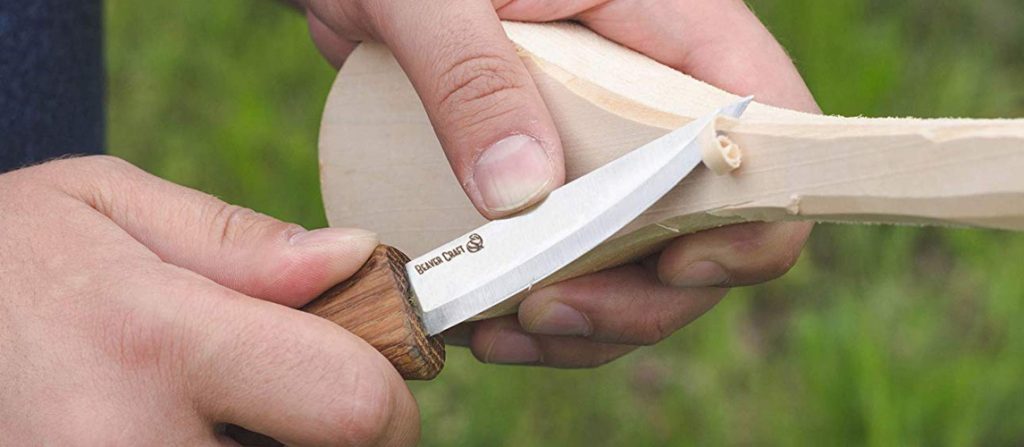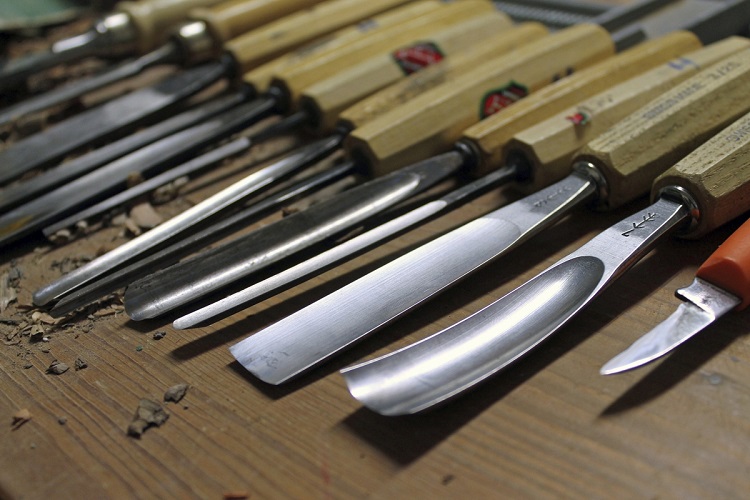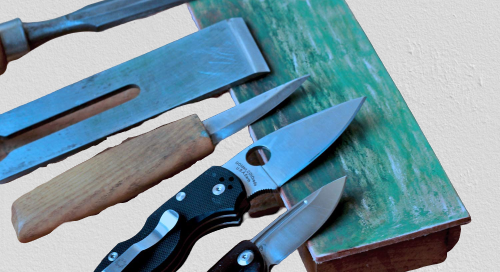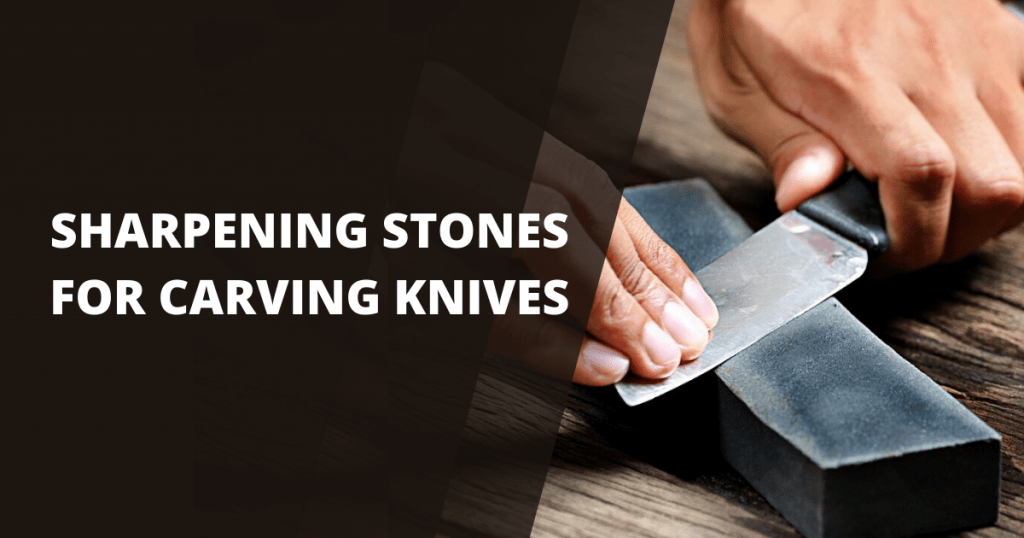Maybe you’ve been doing some great wood carving and producing some fantastic looking bowls, plates, even larger more complex pieces such as furniture or perhaps some really intricate carving detailed work.
It might now be time to give your hard-working tools some attention. You may have noticed them becoming a little blunter than usual after all your woodwork and therefore looking to get them back to their former glory.
In this article, we’re going to look at sharpening stones for carving knives, how to sharpen your knives using a carving stone and other important considerations when getting your carving knives sharp and ready for your woodcraft.
Let’s start by looking at the brief answer as to what to look out for when choosing a carving stone.
What do I look for when choosing a sharpening stone? When you’re ready to sharpen wood carving knives, make sure you choose a stone that has a non-slip surface. This is important to protect yourself and your blades. Stones which offer a variety of course and fine grit is also important. Stones that use water or are used dry are also a good option.
Now that we’ve seen a quick answer as to some of the crucial elements to look out for when choosing a stone, let’s begin by looking a little more closely at one of the main considerations when sharpening your knives, which demonstrates the importance of starting with great quality carving knives.
Contents
Start with a great quality knife
It stands to reason that before you begin the process of sharpening with a great quality sharpening stone, that it’s important to make sure your tools are of good quality to begin with.
Hopefully, you have purchased a good knife with good steel. If not, look for a well-known brand. If you have any doubt about the quality, ask a woodcarver or reputable knife dealer or do some research online
It’s possible to find some great carving knives, which will give excellent results at reasonable prices on Amazon. So good quality carving knives need not necessarily be expensive.
Price doesn’t necessarily equal quality. However do be aware of brands that experts or ‘those in the know’ haven’t heard of before – because unfortunately, as in most things, there’s always someone looking to make a quick buck.
Unscrupulous dealers will do all they can to maximize on a new hobbyist’s enthusiasm, so be aware of this, and do some thorough research before you buy. I’ve highlighted some of what I believe are decent tools earlier, and I’ll offer a few more as we continue.

What am I looking for in a good carving knife?
So this brings us neatly to what you should be looking for in a good carving knife. A good quality carving knife should have an excellent quality steel blade. This is one of the most important considerations for beginners and professionals alike.
Make sure you choose a carving knife with corrosion-resistant alloy steel. This will ensure your blade won’t rust and has a long life. The best quality steel will stay sharp for a good amount of time during your woodworking process.
Also, check the handle is made of solid great quality hardwood such as walnut which not only is durable and long-lasting but will also be easier to control.
“A good quality carving knife should have an excellent quality steel blade.”

Now we know you are fully armed with the best tools, let’s delve a little deeper into the sharpening process and start by deciding whether you should be sharpening your tools or if there’s another method.
Do I need to sharpen my tools?
As there is such a variety of woodturning tools made to different specifications and blades, it’s important to look carefully into the different sharpening process of tools to find out which works the best.
For instance, as plane irons and wood chisels have a straight edge, the steel is often much thinner with a more defined angled edge, which makes them more delicate and difficult to sharpen.
With these kinds of smaller tools. Sometimes honing is a better process than sharpening on a grindstone. This will simply sharpen the edges of the blade to enable you to work with accuracy and quality.
Also as carving tools often have a bent edge which means the contact on the grindstone is too small to be effective. This results in very high pressure being applied on the blade, even if your own pressure on the tool is low.
It can be that the case that on some tools that have a curved edge that is quite delicate, the recommendation by experts is they shouldn’t be sharpened on a stone, but simply honed.
‘carving tools often have a bent edge which means the contact o
the stone is too small to be effective’
What is honing?
A honing strap works by realigning the very fine edge of the blade and polishing the blades surface. After use or sharpening the blade will have a slight burr. It’s this burr that catches when you attempt to cut.
So honing should be done at the final part of the sharpening process, or as previously mentioned,for those knives too delicate and blades with fine edges.

When should I sharpen?
Although some carving tools would only be honed. There are some cases when you can use a grinding stone. Let’s take a look at a few below:
- The blade edge has become damaged
- The edge is too dull to be honed
- You perhaps would like to alter the shape of the edge, for instance, the edge plane angle
So now let’s take a closer look at some methods of honing and sharpening to get your tools back to their original precision. We will start by looking at three of the usual methods.
The 3 best ways to sharpen wood carving knives on a stone
- Push the knife away from you, as if you are trying to take a thin slice out of the stone With the blade close, but an angle to the stone
- Drag your knife towards you with the sharp side of the blade trailing
- Make small circular motions with your blade at a slight angle on the stone
The usual advice is to follow tip number 1, as this is what most experts and woodturners choose.
So you may now be wondering what exactly a sharpening stone is and where you can get one. Let’s take a look below for some more details.
What is a sharpening stone and where can I get one?
As mentioned above it’s really important to get good quality sharpening stones. Sharpening stones with a nonslip base is essential to make sure you get the best results.
This is usually made of silicone and holds the stone within the base while you sharpen. This will give you the confidence to maintain the sharpening angle for the best results. Not to mention the safety aspect.
Sharpening stones with water as the lubricant are generally recommended as you don’t need to buy additional oils and of course, are less messy.
Diamond sharpening stones are also highly recommended. They usually offer a coarse and fine sanding grit. They also do not require sanding oils and you can even sand completely dry, without water.
“Sharpening stones with a non-slip base are essential
to making sure you get the best results.”
And finally…
We hope this article has been useful in providing you with details on how to get the best out of sharpening carving knives using sanding stones.
If you need any more information on anything you’ve read today, check out our resource page which will provide more help.




